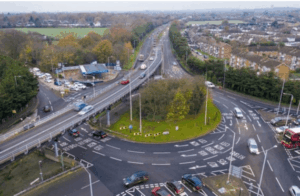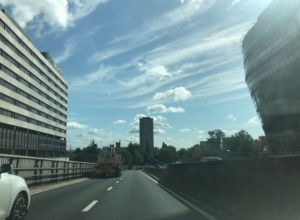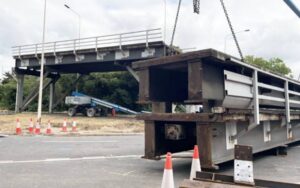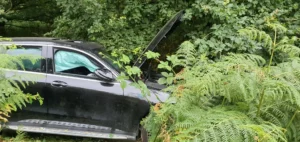Transport for London has been working on a number of innovative techniques that have allowed it to maximise the usefulness of its bus priority equipment and increase our bus priority capability. Here, Michael Bloomfield and David Oram of TfL outline how all these work streams again have the objective of helping buses to get through the network with lower delays, saving time and increasing reliability for the travelling public.
More details about this project will be given at the JCT Traffic Signals Symposium in Nottingham, which takes place on 15 and 16 September.
Transport for London’s Network Performance Delivery (NPD) team is responsible for setting up, operating and optimising London’s UTC traffic control system. A key part of this includes Bus Priority (BP) in SCOOT, known as PROMPT (PRiority and infOrMatics for Public Transport).
Bus Priority (BP) at junctions works by either extending the current green signal time at the end of a stage to allow a bus through (an “Extension”), or by shortening opposing stages to give the bus green more quickly (a “Recall”).
At junctions where Standard BP (SBP) is not suitable Differential Bus Priority (DBP) can be implemented. DBP uses bus schedule information and typically prioritises only delayed buses. This allows an increased amount of priority to be given to late-running buses.
Below is a summary of BP equipment and configuration in London (data taken from August 2021);
- 1925 sites with Bus Priority
- 1534 sites with BP on UTC
- 1128 on UTC running SBP
- 406 on UTC running DBP
- 391 sites with BP on VA
- 6280 VDPs (Virtual Detection Points)
Innovative Techniques to Increase Levels of BP on the UTC System
1. Bus Priority Optimisation Reviews
The use of SCOOT data (specifically time spent in “BP Override”) to identify poor performing bus priority junctions was discussed in Michael and David’s presentation last year. A successful pilot programme of “Bus Priority Optimisation (BPO) Reviews” followed. 32 such reviews were then completed between September 2020 and March 2021 (giving a total of 728.5 passenger hours saved per day, 22.8 hours per day on average per location).
This success has led to a further 50 BPO reviews being added to the NPD Timing Review Programme for 2021-22. However, one key additional data set has been added to allow this year’s BPO review programme to be even more targeted – bus numbers at the junction.
For example; a junction spending not much time in BP Override may be performing in such a way due to the simple fact that very few buses pass through it. Low numbers of buses would naturally give few opportunities for bus priority to occur and therefore have a low override time. Such a site would not offer great opportunity for improvement, but purely considering “BP Override” data alone would’ve indicated it needed a BPO review.
Therefore, by combining both override time with bus numbers we’re able to identify sites that fall outside of an expected operating threshold (e.g. a high override time per bus indicates a poor performing site in need of review).
2. Bus Virtual Detection Point review
A Virtual Detection Point (VDP) is the location at which buses are detected, typically on the approach to traffic signals. “Seeing” the bus is the first step towards assigning it priority. VDPs can have different stop conditions associated with them, “0” if a bus is approaching the signals in free flow (i.e. not stopping), and “2” if there is a bus stop on the approach.
A recent project has been able to identify all VDPs with a stop condition of 0 and with a bus journey time (BJYT) of 4seconds or lower (a low BJYT reduces the likelihood of extensions occurring). The stop condition is critical here as stop condition 0 VDPs may be able to be moved as they are not constrained by a bus stop being present. Stop Condition 2 VDPs with low BJYTs are not movable as these are located by bus stops.
156 VDPs were identified that fit these criteria (stop condition 0, bus journey time 4seconds or lower) and each is being investigated to assess whether they could be moved further from the stop line. This would give an increased BJYT and more time for the signals to grant an extension.
This review is currently ongoing but follows a pilot study where 11 VDPs were moved, with BJYTs being increased from 4seconds or lower to a new (higher) value. These 11 VDPs, once moved, saw an increase in Central Extensions of over 53%.
Given that VDPs are not a physical piece of infrastructure, moving them only requires an update to coordinates and this represents a low-cost way of delivering more BP on our network.
3. Virtual Detection Point (VDP) to stop line distance compared to UTC system entered Bus Journey Time (BJYT)
The importance of bus journey time was briefly mentioned in the previous section. Not only does this value govern the likelihood of extensions occurring, but it also determines how effective the bus priority granted really is.
An incorrect bus journey time could result in buses clearing the stop line (as modelled in the UTC System) but not actually clearing the stop line on street. In this scenario, the bus would have benefitted from a BP extension but did not receive one. Conversely, the bus could clear the stop line on street but not clear in the system and bus priority could be granted in error, causing unnecessary disruption to junction operation.
4. Local Extension (LEX) Upskilling & Local Extension Timer update
As mentioned in the introduction, the amount of LEXs granted on our system has been in decline since we started recording detailed data in 2018. To reverse this trend, some recent investigative work has broadened our understanding of LEXs. This work took on multiple strands;
1 – Through detailed SCOOT & BP message analysis we now fully understand how we can influence and increase the likelihood of LEXs being granted, and therefore can update system parameters. LEXs are not the “poor cousin” to Central Extensions that we once thought, they are granted differently and have potential advantages.
2 – A study has been completed to assess the impact of allowing LEXs to occur at Differential Bus Priority (DBP) sites. This was previously not advised due to the potential for disruption and for granting priority to buses that were not behind schedule. However, the study proved a success; the level of disruption was low with the overall benefits being high. Our guidance on allowing LEXs to occur at DBP sites has now been updated.
3 – An update to our “LEX Calculator” tool has been completed – this update accounts for the findings (from point 1 above) and gives Network Managers an easy to use method to configure and review LEX timers set in the controller.
4 – A mass data extraction of all LEX timers configured in controllers was completed.
5. Bus Route Configuration Tracker
For buses to be detected and BP to be granted at a junction a BP configuration must be completed, detailing which routes travel through the junction and are therefore expected to be “seen” at the VDP. The configuration is often completed at the time of BP implementation / enabling.
However the 675 bus routes in London undergo both schedule and route alterations over time as travel patterns change and TfL responds to customer demands. This results in buses no longer travelling through the junctions they did previously, but importantly also results in them now travelling through new junctions on their route. When such changes occur, BP configurations are not automatically updated and therefore buses are not detected and would not receive BP.
Conclusion
Each of the projects described are contributing to more opportunities for buses to travel through our network with lower delay and have been delivered at extremely low cost. This is especially the case when compared to the high costs of civil schemes or deploying new BP equipment. By accessing, analysing and acting upon the vast datasets we hold, we can target our limited resources at those junctions which will benefit the most from our attention.
Consistent with those initiatives presented last year, TfL’s Network Managers have been trained on how to use these techniques / new datasets and the BP statistics we collect provide evidence that their application has been a success.
(Graph – TfL)




















